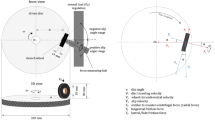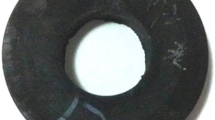Abstract
The chapter provides a brief overview of the abrasion mechanisms occurring on automotive tires. Particular attention is paid to fatigue abrasion, which is especially the cause of mass loss in passenger car tires in public road traffic. The framework of the paper is a very simple physical model (Resnikowskij, Kautschuk Gummi Kunststoffe 9:33–37, 1960) of the relationship between abrasion and friction work during Hertzian contact and sliding friction of rubber over the periodical roughness of a road. Essential physical quantities of the rubbers determined in the laboratory, such as modulus, tensile elongation, coefficient of friction, and a Woehler-like fatigue parameter, give an expression for laboratory fatigue wear that correlates very well with tire wear under an outdoor test program commonly used by tire companies on public highways. This result also makes it clear why tire wear under moderate severity conditions cannot be described by abrasive wear tests in the laboratory, e.g. with DIN-Abrader.
Access this chapter
Tax calculation will be finalised at checkout
Purchases are for personal use only
Similar content being viewed by others
References
Veith AG (1992) Rubber Chem Technol 65:601
Veith AG (1987) Polymer Testing 7:177
Veith AG (1995) Tire Sci Technol 23:212
Veith AG (1973) Rubber Chem Technol 46(801):821
Gieré R et al. Tire abrasion as a major source of microplastics in the environment, present book volume
Penkala M, Ogrodnik P, Rogula-Kozlowska W (2018) Particulate matter from the road surface abrasion as a problem of non-exhaust emission control. Environments 5:9. https://doi.org/10.3390/environments5010009
Cadle SH, Williams RL (1978) Rubber Chem Technol 51:7
Cadle SH, Williams RL (1979) Rubber Chem Technol 52:147
Schallamach A (1952) J Polym Sci 9:385
Schallamach A (1968) Rubber Chem Technol 41:209
Grosch KA, Schallamach A (1961) Wear 4:356
Schallamach A, Turner DM (1960) Wear 3:1
Kragelsky IV, Nepomnyashchi EF (1965) Wear 8:303
Grosch KA (1992) Rubber Chem Technol 65:1
Grosch KA, Schallamach A (1969) Kautschuk Gummi Kunstst 22:288
Grosch KA, Schallamach A (1970) Rubber Chem Technol 43:701
Grosch KA, Schallamach A (1965) Trans Inst Rubber Ind 41:80
Grosch KA, Schallamach A (1966) Rubber Chem Technol 39:287
Muhr AH, Roberts AD (1992) Wear 158:213
Gent AN, Nah C (1996) Rubber Chem Technol 69:819
Southern E, Thomas AG (1978) Plast Rubber Matter Appl 3:133
Thomas AG (1974) J Polym Sci Polym Symp 48:145
Pulford CTR (1983) J Appl Polym Sci 28:709
Gent AN, Pulford CTR (1983) J Appl Polym Sci 28:943
Sakai H (1996) Tire Sci Technol 24:252
Kienle RN, Dizon ES, Brett TJ, Eckert CF (1971) Rubber Chem Technol 44:996
Heinrich G, Rennar N, Dumler H (1996) Kautschuk Gummi Kunststoffe 49:32
Stalnaker D, Turner J, Parekh D, Whittle B, Norton R (1996) Tire Sci Technol 24:94
Wu G (2016) The mechanisms of rubber abrasion, Ph.D. thesis, Queen Mary Univ. of London
Wunde M, Klüppel M, Vatterott C, Tschimmel J, Lacayo-Pineda J, Schulze A, Heinrich G (2019) Verbesserung der Laborvorhersagen zum Risswachstum und Verschleiß von LKW-Reifenlaufflächen. Kautschuk Gummi Kunststoffe 72:72–78
Stoček R, Heinrich G, Schulze A, Wunde M, Klüppel M, Vatterott C, Tschimmel J, Lacayo-Pineda J, Kipscholl R (2020) Chip & cut wear of truck tire treads: comparison between laboratory and real tire testing. Kautschuk Gummi Kunststoffe 73(6):51–55
Stoček R, Mars WV, Robertson CG, Kipscholl R (2018) Characterizing rubber’s resistance against chip and cut behaviour. Rubber World 257:38–40
Stoček R, Mars WV, Kipscholl R, Robertson CG (2019) Characterisation of cut and chip behaviour for NR, SBR and BR compounds with an instrumented laboratory device. Plast Rubber Compos 48:14–23
Resnikowskij M (1960) Kautschuk Gummi Kunststoffe 9:33–37
Landau LD, Lifschitz EM (1970) Lehrbuch der theoretischen Physik. Band 7. Elastizitätstheorie, Akademie-Verlag, Berlin
Abraham F, Alshuth T (2015) Marvalová, Petriková (eds) A new fatigue wear simulation method for road tyre wear, proceedings of constitutive models for rubber IX Taylor & Francis Group, London, pp 123–126, 978-1-138-02873-9
Acknowledgement
We thank our former project partners Continental AG and Bayer AG for the support of this work within the past joint project “Predictive Laboratory Testing of Tire Performance.” We thank Continental Reifen Deutschland GmbH for their agreement to publish this article.
Author information
Authors and Affiliations
Corresponding author
Editor information
Editors and Affiliations
Rights and permissions
Copyright information
© 2022 The Author(s), under exclusive license to Springer Nature Switzerland AG
About this chapter
Cite this chapter
Heinrich, G., Klüppel, M. (2022). Basic Mechanisms and Predictive Testing of Tire-Road Abrasion. In: Heinrich, G., Kipscholl, R., Stoček, R. (eds) Degradation of Elastomers in Practice, Experiments and Modeling. Advances in Polymer Science, vol 289. Springer, Cham. https://doi.org/10.1007/12_2022_113
Download citation
DOI: https://doi.org/10.1007/12_2022_113
Published:
Publisher Name: Springer, Cham
Print ISBN: 978-3-031-15163-7
Online ISBN: 978-3-031-15164-4
eBook Packages: Chemistry and Materials ScienceChemistry and Material Science (R0)




